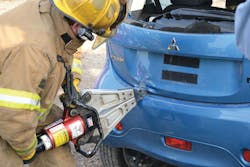University of Extrication: Electric Plug-In Vehicle Extrication Techniques - Part 4
SUBJECT: Electric Plug-In Vehicles
TOPIC: Extrication Challenges of Electric Plug-In Vehicles
OBJECTIVE: Understand any unique procedural changes necessary when accomplishing vehicle rescue tasks on an electric plug-in vehicle.
TASK: Given an electric plug-in vehicle to review and inspect, the rescue team shall review and make any necessary revisions to their existing procedures for accomplishing vehicle rescue tasks on an electric plug-in vehicle.
In our series of columns on extrication involving electric plug-in vehicles, we have looked at how the fundamental vehicle rescue tasks that we perform at crash scenes can differ when the vehicle we are working on is an electric plug-in vehicle. We learned that the sequence of turning off the ignition before we take away the 12-volt electrical power is very important to the success of that task. We have also discussed the challenges presented during vehicle stabilization work when the vehicle has a floorpan-mounted high-voltage battery. In this, the final part of our series, we look at several other extrication-related assignments that can have a new twist to them.
During the research work conducted on a 2012 Mitsubishi i-MiEV electric plug-in vehicle, it was determined that side-window and windshield glass removal is no different from that with a conventional vehicle. Due to the aerodynamic shape of the vehicle, removing the windshield glass by itself would have meant cutting a bit more glass than we are used to, but still it was no special challenge.
The doors on the i-MiEV could be forced and the hinges attacked to allow for door removed using conventional methods. Opening the rear hatchback took just a bit of maneuvering until we were able to get a good bite with a power spreader, force the rear latch to its failure point and open the hatchback.
When it came to accomplishing total roof removal, the “split A-pillar” design was encountered. The A-pillar on the i-MiEV split into actually two posts at dashboard level. All this meant during the roof removal task was that we had to make two cuts to completely cut through the A-pillar on each side. The metal was cut easily in our research with a power cutter as well as a reciprocating saw.
A concern arose when considering any “real-world” situation where a crew would decide to ‘roll the dash’ on an electric plug-in vehicle. Our i-MiEV had a floorpan-mounted battery. If a crew were to use a power ram, for example, to roll the dash, the concern would be that the base end near the bottom of the B-pillar would not be allowed to push down or puncture into the floorpan of the vehicle at all. Directly beneath the metal floor are the cells of the high-voltage battery. Caution would have to be observed during a dash roll evolution.
For our research, the dash and firewall movement was accomplished by using the “jacking the dash” evolution. Cuts were made in the lower A-pillar, a notch was created, and a power spreader jacked the dash and instrument panel structure up and away from our simulated patient. Even in this situation however, concern exists that any portion of the floorpan does not crush downward, potentially damaging the floorpan-mounted battery below. Good cribbing beneath the rocker helped make our task successful.
In addition, because of the battery being beneath the floorpan, rescuers would have to be cautious when accomplishing any seat movement or seat removal work. The floorpan would have to be monitored to ensure that it is not crushed downward causing damage to the lithium-ion battery cells below.
TASK: Given an electric plug-in vehicle to review and inspect, the rescue team shall review and make any necessary revisions to their existing procedures for accomplishing vehicle rescue tasks on an electric plug-in vehicle.
Read the rest of the series here:
About the Author
Ron Moore
RON MOORE, who is a Firehouse contributing editor, recently retired as a division chief with the McKinney, TX, Fire Department and now serves with Prosper, TX, Fire Rescue. He self-published the Vehicle Rescue 1-2-3 training manual and serves as the forum moderator for the extrication section of Firehouse.com . Moore can be contacted directly at [email protected].

